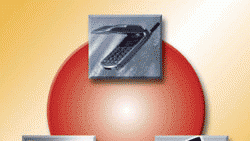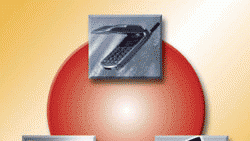Video for mobile users

I am one of those who believes that we overestimate the speed of technological change in the short-term and underestimate it in the long-term. We are like passengers in fast-moving cars, on a road that is slowly bending to the right. We cannot see what is there beyond the bend — we cannot see the event horizon — but the road is good, and there are many different signs guiding us, so we continue.

The triangle of new services is formed of digital television, the mobile phone and the computer. They all interact with each other, creating new business opportunities for years to come.
The problem with these signs is that they are all new to us. We may know what they might mean in theory, and for a decent fee, there are plenty of people ready to tell us what they really mean, according to their best estimates. Yet we are still unclear as to how the signs will actually correspond with reality after the bend.
We have already passed many of these new signs, such as global system for mobile communications (GSM), short message service (SMS) and wireless application protocol (WAP), with varying degrees of success. Indeed, a lot of money has been lost along the way, especially with WAP. Here in Finland, for example, there are 5.2 million people and 4.2 million portable phones, and with such figures, one might have expected to be able to create interesting services for WAP phones. Our best WAP portals were created by large companies and professional communicators who offered almost anything one could hope for, from news to horoscopes, from stock prices to betting tips. And they failed.
People were neither used to, nor willing, to read their horoscopes from tiny, stamp-size screens with a rather clumsy interface, and neither were they willing to pay for every piece of information they got. Our best WAP portals failed despite their abundant content, not because of it. Using our traffic analogy, the speed of the WAP builders was not right for the situation.
New signs, new promises
Given the abundance of new terms such as QPSK, 64-QAM, GPRS, EDGE, MMS, UMTS, Wi-Fi, HRF, Bluetooth 2, HYPERLAN 2, MHP and so on, what do we choose? Added to that are developments such as the new modem announced in September 2002 by the State Research Center in Northern Finland. Supposedly 20 times faster than wireless LAN and 200 times faster than Bluetooth, the new modem will also be cheap and ready for use as soon as late 2003.
The professional video industry's #1 source for news, trends and product and tech information. Sign up below.
With so many possibilities on offer, we must base our decisions on a genuine understanding of the present, and know how to use, fully and creatively, those technologies that are available right now. But even that is not as straightforward as it might seem, thanks to our customers.
SMS messages
Finnish people send 3 million SMS messages a day with their mobile phones. According to a recent study, 2.7 million of these are from one person to another and comprise messages such as ‘Where are you?’, ‘Congratulations...,’ ‘Have you heard...’ and so on. The remaining 300,000 are messages that are sent to order various goods or services. Of those services, 75 percent are for ring tones for the phones, logos for the phone screens and participation in a chat program on television.
That leaves only 75,000 messages per day for something other than personal communication or entertainment. If your business is, for instance, selling news for mobile phones, your organization must be really lean to make a profit. Even if servicing mobile phones is only a small part of your operation, you still need heavy marketing and advertising efforts to increase significantly your share of the 3 million daily messages.
We can also learn something from the fact that the vast majority of messages sent daily are interpersonal, namely that the contact itself fulfills a deeper need for feeling secure through being noticed and remembered, and not left feeling lonely.
MMS: The next step
In September 2002, the Finnish Broadcasting Company (YLE), in association with an SMS news service, started a multimedia messaging service (MMS) picture news service for new MMS-enabled mobile phones. It will take some time before even 10 percent of Finland’s 4 million mobile phones understand the MMS protocol, but they will eventually, and so now is the time to gather experience. We expect the picture news service to become reasonably popular, especially in the ‘breaking news’ category.
The pattern of SMS traffic will probably repeat itself in MMS traffic — with one notable addition. Individuals will send pictures that they have taken to the phones of other individuals. The novelty will be the traffic of pictures from private phones to media, print and television, resulting in a whole new interaction between the traditional producers and consumers of information. Pictures from omnipresent phones will give birth to new types of stories, publications and program formats, and picture phones will open unforeseen possibilities for a multitude of national and international organizations. In the hands of all kinds of activists and lunatics, a picture phone can be a tool or a weapon.
Streaming pictures
There are already a couple of mobile phones that are capable of showing streaming video, and as a public broadcaster, YLE is ready to service such mobile users with its news programs. It can be done today, and upscale as soon as the user demand, the technology and the bandwidth meet at a feasible level. Partnerships with broadcasters and wide-area network providers will be fruitful.
For the viewer, the most important thing is to receive a watchable picture. Although watchability itself depends greatly on the rarity, novelty and personal value of the pictures, it is probable that video phones will lower the overall level of watchability, especially for news services. Nonetheless, in everyday use, a jerky flow of pictures with lots of dropping frames will hardly do as people are accustomed to a rather high technical quality, thanks to analog television.
All in all, we are witnessing the birth of a new power structure in communication. The triangle of new services, already under worldwide construction, is formed of digital television, the mobile phone and the computer. They all interact with each other, more inventively every week, creating new business opportunities for years to come. The growth center of the digital future is 3-dimensional. For public broadcasters and commercial entities alike, it is wireless, interactive and personalized.
Erkki Vihtonen is project manager for YLE Internet, Finnish Broadcasting Company.
